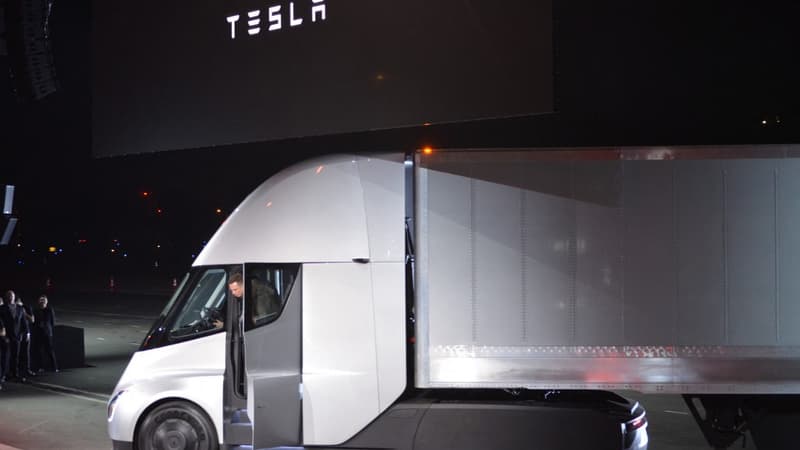With the delivery of its first electric truck, dubbed the Semi, on Thursday, Tesla wants to shake up the nascent market for emission-free trucks by promising to drive long distances without stopping at the charging station. Elon Musk’s group is due to hand over the vehicle keys to the PepsiCo food group at the Sparks, Nevada, plant on Thursday. The truck, with a cab with rounded lines, was presented in 2017. But the launch of its full-scale production, initially scheduled for 2019, has been delayed.
Other automakers have already invested in the niche, be they traditional heavy-vehicle makers like Daimler, Volvo, Traton (a Volkswagen subsidiary) and China’s BYD, or start-ups like US-based Nikola. Deliveries are just beginning, but many orders have been placed. But the truck “that the market has been waiting for some time is Tesla,” says Dave Mullaney, a transportation specialist at sustainability firm RMI.
“The battery must be very big”
The other manufacturers, taking advantage of their experience in heavy vehicles, have above all transformed a diesel truck into an electric one. Tesla, for its part, is launching a truck “designed to be electric from the ground up,” he says. If the US group follows through on its promises “it will make a big difference.” Elon Musk said in a tweet on Saturday that the truck had traveled 500 miles (805 kilometers) without recharging, with a total weight of almost 37 tons, when the vehicles currently on offer offer a range of 250 to 300 miles (400 to 480 kilometres). . ).
To be able to transport heavy loads over long distances, “the battery must be very large; it is heavy, it takes up space and it is very expensive”, recalls Mike Roeth, director of the North American Council for Transportation Efficiency (NACFE). “Industry players have long wondered if it’s physically possible to have a battery that’s powerful enough without being too heavy to get the job done.”
The transition to electric vans that deliver across town or over short distances has been underway for some time. If heavy electric vehicles can go 800 kilometers without having to recharge, this opens the niche for long-distance journeys, with a return to the depot the same afternoon or over several days if the driver can find a terminal to take a break. . .
new regulations
Manufacturers and carriers abide by the regulations. In the United States, California approved a law that provides for the gradual elimination of trucks with combustion engines, imitated since then by other states. The European Union must discuss new standards in the coming months. Companies are also paying more and more attention to being environmentally conscious in order to preserve their reputation. They “want to be on the right side of history,” remarks Marie Chéron, of the European Transport & Environment association.
Those who do not engage in a decarbonisation strategy, sometimes with the idea of letting technologies improve a little more, “are left behind”, he also argues. Another bonus: Drivers who have been able to test drive them “love electric trucks,” says Mike Roeth. “They’re quiet, there’s no exhaust, they’re easier to drive.”
For the adoption of electric trucks to accelerate, it is necessary that the autonomy really corresponds to the promises and ideally that the batteries are smaller, say several analysts interviewed by AFP. Infrastructure must also adapt, with more charging stations and a power grid strong enough to allow, for example, ten trucks to connect to a parking lot at the same time. The price will be decisive.
Still 70% more expensive to buy
For now, buying an electric truck still costs about 70% more than buying a diesel truck, but it costs less in terms of power and maintenance, says Dave Mullaney. “Electric vehicles will be competitive with diesel (…), it is only a matter of time,” said a spokeswoman for the US manufacturer Navistar, a subsidiary of Traton. Tesla now must “show that it can produce at scale,” said Wedbush’s Dan Ives.
Elon Musk indicated in late October that his goal was to build 50,000 Semis by 2024. He proved in 2018, when production of the Model 3 sedan was struggling to ramp up, that he knew how to get his teams up and running. But the attention the businessman is currently paying to his latest acquisition, Twitter, “is taking a backseat to what should be a great moment in Tesla’s history,” laments Dan Ives.
Source: BFM TV


